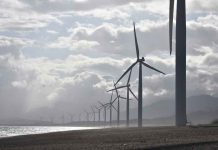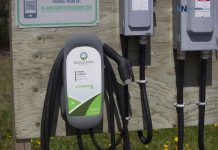 Galway, Ireland – Germany’s latest offshore windfarm has been completed but faces months of delay before it can be connected to the grid due to the need to clear World War II (WWII) ammunition from the seabed.
Galway, Ireland – Germany’s latest offshore windfarm has been completed but faces months of delay before it can be connected to the grid due to the need to clear World War II (WWII) ammunition from the seabed.
The 108-megawatt (MW) Riffgat windfarm located in the German North Sea was officially opened in recent weeks and was expected to start providing power to thousands of homes this month. However, Dutch company TenneT TSO BV (Arnhem, Netherlands), one of Germany’s four grid transmission operators, has announced that the windfarm’s connection will have to be pushed back until it clears the dumped WWII ammunition from the seabed.
TenneT still has to install the last section of the 50 kilometer (km) cable connecting the windfarm, located near the island of Borkum, to the national electricity grid on the German mainland. The company has given a tentative date of February but said it cannot guarantee that as the task is proving more complex and difficult than originally expected.
Developer of the windfarm, EWE, is not happy about the delays, as the windfarm is using more power than it is producing. “We could start feeding energy but the firm responsible for connecting the wind farm to the energy network hasn’t done its job so we’re forced to wait,” complained EWE’s project’s manager, Irina Lucke.
Riffgat is Germany’s first commercial offshore wind farm in the North Sea. With a total output of 108 MW, it can generate enough electricity for around 120,000 households. It uses 30 SWT-3.6-120 turbines manufactured by Siemens, each rated at 3.6 MW.
At the official launch, Prime Minister Stephen Weil stated: “Offshore is an essential and indispensable pillar of energy policy. Riffgat to the wind farm will make a significant contribution”. This is not the first time that Dutch-owned grid operator TenneT has come under fire from energy companies in Germany, with both E.ON AG (OTC:EONGY) (Dusseldorf, Germany and RWE AG (OTC:RWEOY) (Essen, Germany) blaming the company for offshore project delays.
Last summer, RWE announced that it was postponing its first German offshore wind project — the 295 MW Nordsee 1 windfarm – blaming uncertainty over ongoing grid connection issues with the government. For additional information see July 31, 2012, article – RWE Delays Nordsee Offshore Project.
In September, the German government set out to reduce the delays in getting offshore windfarms built by introducing a bill that will see consumers and grid operators being charged more if there are any more serious delays to getting windfarms built and connected to the grid. For additional information, see September 3, 2012, article – German Bill to Drive Offshore Projects.
In October, Dong Energy A/S (Fredericia, Denmark) postponed plans to develop the 346 MW Borkum Riffgrund II, blaming German grid operator, TenneT TSO BV (Arnhem, Netherlands) for not being able to connect the windfarm to the grid on time. For additional information, see October 25, 2012, article – Dong Halts German Offshore Windfarm.
Martin Lynch, European News Editor for Industrial Info













